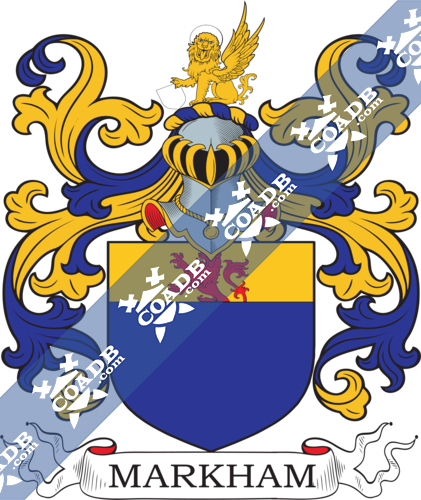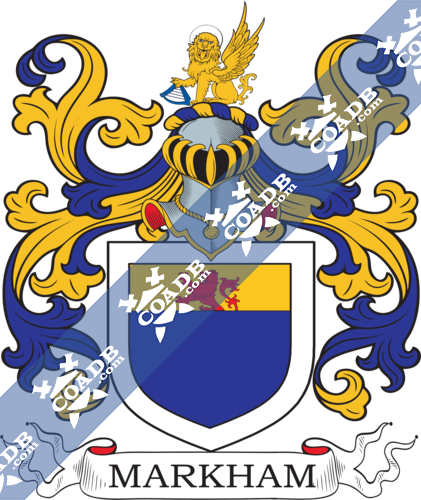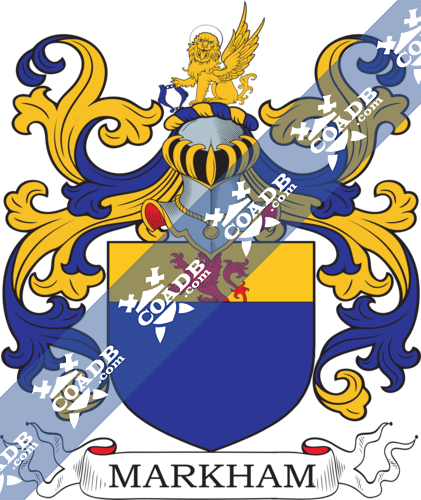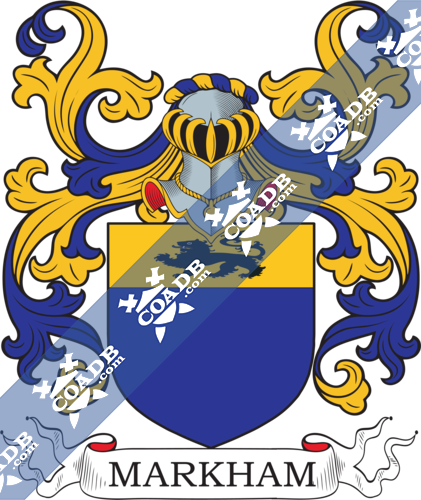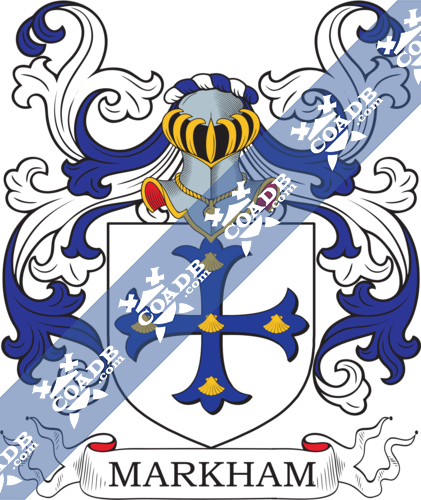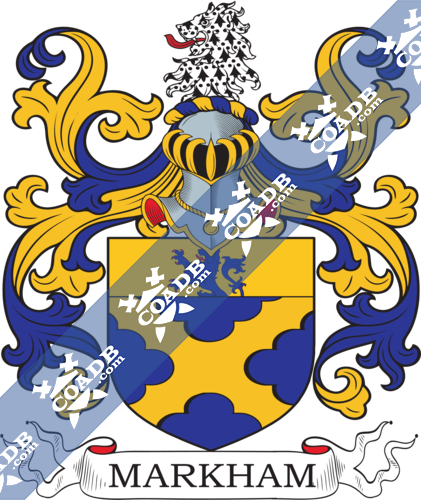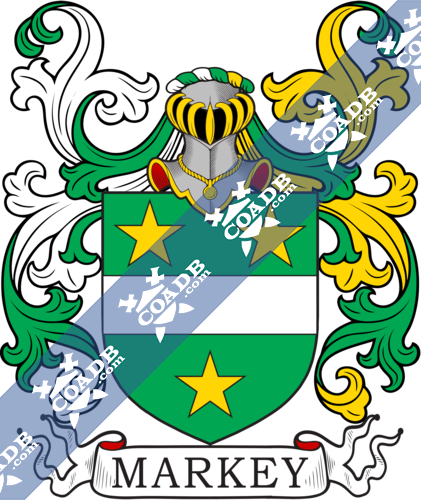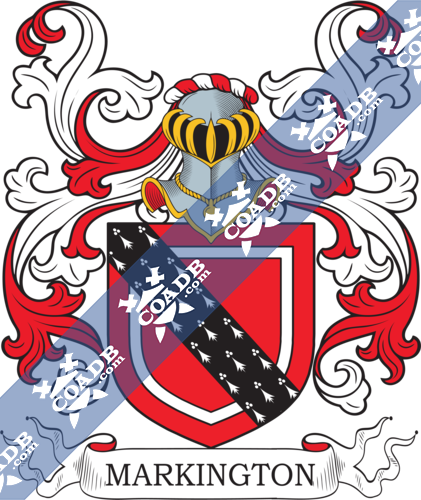Markham Family Crest, Coat of Arms and Name History
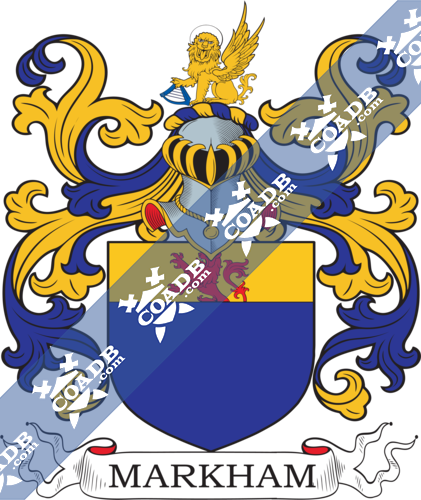
Markham Coat of Arms Gallery
Don’t know which Coat of Arms is yours?
We can do a genealogical research. Find out the exact history of your family!
Learn MoreMARKHAM
The English surname Markham is geographical as it comes from a region located in Nottingham which derives its name from the old English “Mearcham”, a compound word of which the prefix “mearc” translates to boundary and the suffix “ham” translates to homestead. The surname Markham is also thought to be an Anglicized version of the Irish Gaelic O’Marcachain which is patronymic as it translates to descendant of Marcach.
There are additional variations of the spelling of this name which include but are not necessarily limited to; Marcham; Markem; and Markam. The variation in spelling of names during this time period can be attributed to a lack of continuity regarding guidelines for spelling. Many of these record keepers were in the habit of spelling phonetically, however, what may have sounded one way to one person may have sounded completely different to another. The issue of multiple spellings of names in records was which was compounded by the diversity of languages in use in European countries at this time.
Surnames in Europe prior to the mid-sixteenth century were largely unheard of. In the small settlements and villages which existed during earlier times, residents found little need for surnames as everyone in these communities knew each other and a given name would usually suffice. However, with the passage of time, population growth and expansions of communities as villages gave way to towns and cities, it became necessary to add a qualifier to a people’s names to distinguish them, one from another and to make the keeping of tax and census records easier. Therefore, the nobles’ practice of using surnames gained in popularity. In the creating of surnames for the masses, one person may have been identified by their given name plus their occupation while another may have been identified by their given name and one of their parent’s names. There was a boundless supply from which surnames could be formed, in addition to the use of patriarchal/matriarchal names or reference to the individuals occupation, there were things such as defining physical traits, a familiar geographical location or a topographical landmark found near the individuals home or birthplace, the name of the village in which the person lived, and so much more. Soon, surnames would come not just to represent an individual but whole families.
With the discovery of the Americas and the addition to the British Common Wealth of countries such as Canada and Australia, immigration to these new worlds was inevitable. One of the first settlers on record to America bearing this surname was Robert Markham who landed in 1606 and settled in Virginia. Thomas and Susan Markham who arrived in 1636 and settle in Virginia. One of the earliest records of a Markham to migrating to Canada was Jonathan Markham who arrived in 1749 and settled in Halifax, Nova Scotia. One of the earliest records of a Markham migrating to Australia is Margaret Markham who landed in South Australia in 1855. Some of the earliest immigrants to New Zealand were Richard and Elizabeth Markham and their son Albert who arrived in 1874 Ns settled in Auckland, New Zealand.
Worldwide, the highest concentration of people with the surname Markham are found in Australia, the United Kingdom, Ireland, New Zealand, and the United States. State by state, the largest percentile of those with the surname Markham live in Virginia, Connecticut, Maine, Massachusetts, and North Carolina.
There are a number of persons of note who bear the surname such as Admiral Sir Albert Hastings Markham, an English born officer of the Royal Navy, author, and explorer. He was awarded Knight Commander in the Order of the Bath and is renowned for designing the flag of New Zealand.
Sir Arthur Markham, 1st Baronet, born in Birmingham, England, he was an industrialist and member of Parliament. He was created a baronet of Beachborough Park, Newington, Kent in July of 1911.
Sir Clements Markham, a British writer, explorer, and geographer, was primarily responsible for organizing the National Antarctic Expedition of 1901-1904. He was awarded Knight Commander of the Order of Bath and was made a Fellow of the Royal Society.
Sir Robert Markham, 1st Baronet of Sedgebrooke, Lincolnshire, was a British born politician who served in Parliament. Upon his death in February, 1667, his son Sir Robert Markham, 2nd Baronet, succeeded him.
Blazons & Genealogy Notes
1) (Markham, co. Nottingham; descended from Sir Alexander de Markham, Constable of the Castle of Nottingham, temp. Henry III., from whom descended Sir John Markham, Knt., Judge of the Common Pleas from 20 Richard II. to 9 Henry IV., 1396-1407, who had two sons, 1) Sir Robert Markham, ancestor of Markham, of Coatham and Allerton, co. Nottingham; and 2) Sir John Markham, Lord Chief Justice of the King’s Bench, temp. Henry VI. and Edward IV.). Az. on a chief or, a demi lion ramp. issuant gu. Crest—A lion of St. Mark sejant guard. winged or, circled round the head ar. supporting a harp or lyre of the first.
2) (Sedgebrooke, co. Nottingham, bart., extinct 1779; descended from Sir John Markham, Lord Chief Justice of the King’s Bench, temp. Henry VI. and Edward IV.). (William Markham, Bishop of Chester, 1771-77; Archbishop of York, 1777-1807, stated to have descended from Markham, of Coatham). Same Arms. Crest—A lion of St. Mark sejant guard. resting the dexter forepaw on a shield ar.
3) (Ollerton, co. Nottingham; a branch of Sedgebrooke). Same Arms, with a bordure ar. Crest—A lion of St. Mark sejant guard. winged or, circled round the head ar. supporting a harp or lyre of the first.
4) (Cufforth Hall, co. York; descended from William Markham, Archbishop of York). (Becca Hall, co. York, formerly of Coatham, co. Nottingham; descended from William Markham, Archbishop of York, 1777-1807; William Markham, Esq., of Becca Hall, eldest son and heir of William Markham, Private Secretary to Warren Hastings, settled at Becca Hall, was grandson of the Archbishop of York). Same Arms. Crest—A lion of St. Mark sejant guard. resting the dexter paw on a pair of hames or. Motto—Mitis et audax.
5) Az. on a chief or, a lion pass. sa.
6) Ar. on a cross patoncée az. five escallops or.
(Dublin; confirmed by Roberts, Ulster, 1644, to William Markham, of that city, gent.). Az. a saltire engr. or, on a chief of the last a lion ramp. issuant of the first. Crest—A lion’s head erased erm.

